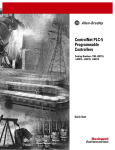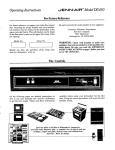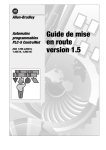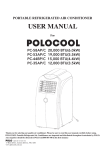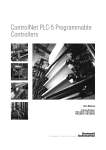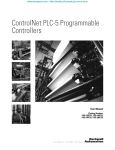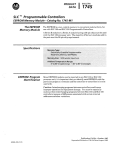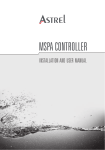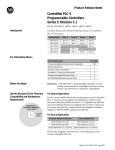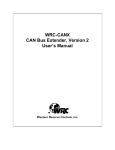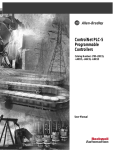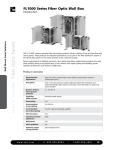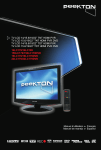Download 1785-10.6, ControlNet PLC-5 Programmable Controllers, Quick Start
Transcript
Allen-Bradley ControlNet PLC-5 Programmable Controllers (Cat. No. 1785-L20C15, -L40C15, -L80C15) Quick Start Phase 1.5 Important User Information Because of the variety of uses for the products described in this publication, those responsible for the application and use of this control equipment must satisfy themselves that all necessary steps have been taken to assure that each application and use meets all performance and safety requirements, including any applicable laws, regulations, codes and standards. The illustrations, charts, sample programs and layout examples shown in this guide are intended solely for purposes of example. Since there are many variables and requirements associated with any particular installation, Allen-Bradley does not assume responsibility or liability (to include intellectual property liability) for actual use based upon the examples shown in this publication. Allen-Bradley publication SGI-1.1, Safety Guidelines for the Application, Installation, and Maintenance of Solid-State Control (available from your local Allen-Bradley office), describes some important differences between solid-state equipment and electromechanical devices that should be taken into consideration when applying products such as those described in this publication. Reproduction of the contents of this copyrighted publication, in whole or in part, without written permission of Allen-Bradley Company, Inc., is prohibited. Throughout this manual we use notes to make you aware of safety considerations: ! ATTENTION: Identifies information about practices or circumstances that can lead to personal injury or death, property damage or economic loss. Attention statements help you to: • identify a hazard • avoid the hazard • recognize the consequences Important: Identifies information that is critical for successful application and understanding of the product. ControlNet is a trademark; PLC is a registered trademark of Allen-Bradley Company, Inc. Preface Preface Read this preface to familiarize yourself with the rest of the manual. This preface covers the following topics: • who should use this manual • the purpose of this manual • conventions used in this manual • Rockwell Automation support Who Should Use this Manual To use this manual, you should understand programmable controllers and be able to interpret the ladder logic instructions required to control your application. For more information, see the documents listed on the following page or contact your local Rockwell Automation representative. Purpose of this Manual This manual introduces you to installing and using a ControlNet PLC-5 processor system. In addition, it shows you how to set up a system using a typical configuration. Since this is a Quick Start manual, we do not cover all of the ControlNet PLC-5 processor features, but give you enough information to get you started. This manual includes: • basic information needed to start using the ControlNet PLC-5 processor quickly and effectively • high-level procedures with cross-references to other manuals for more details Important: The recommended switch settings in this manual help you set up a test system and get it working. Actual switch settings depend upon your application. How to Obtain a User Manual There is a user manual associated with this product that contains detailed information about configuring, programming, and using a PLC-5 processor. To obtain a copy of the ControlNet PLC-5 Programmable Controllers User Manual, phase 1.5, publication number 1785-6.5.22, you can either: • view or download an electronic version from the internet: www.theautomationbookstore.com • purchase a hardcopy from the internet: www.theautomationbookstore.com • contact your local distributor or Rockwell Automation representative to place an order. See the table on the next page for other related publications. Publication 1785-10.6 - November 1998 P-2 Preface Related Documentation The following documents contain additional information concerning the products discussed in this manual. For more information about: See this publication: Publication number: ControlNet PLC-5 programmable controllers (1785-L20C15, -L40C15, and -L80C15) ControlNet PLC-5 Programmable Controllers User Manual, phase 1.5 1785-6.5.22 Enhanced and Ethernet PLC-5 Programmable Controllers User Manual 1785-6.5.12 1785 Enhanced PLC-5 Processor System Overview 1785-2.36 ControlNet System Overview 1786-2.12 1785 PLC-5 Programmable Controllers Quick Reference 1785-7.1 PLC-5 Programming Software Instruction Set Reference Manual 1785-6.1 Industrial Automation Wiring and Grounding Guidelines 1770-4.1 ControlNet Cable System Component List AG-2.2 ControlNet Cable System Planning and Installation Manual 1786-6.2.1 ControlNet Coax Tap Installation Instructions 1786-2.3 ControlNet Network Access Cable Installation Instructions 1786-2.6 ControlNet Repeater Installation Instructions 1786-2.7 Universal 1771 I/O chassis Universal I/O Chassis installation instructions 1771-2.210 power supply (1771-P4S) Power Supply Modules (1771-P4S, -P6S, -P4S1, -P6S1) installation instructions 1771-2.135 Allen-Bradley Publication Index (for your specific power supply) SD499 Enhanced and Ethernet Programmable Controllers User Manual 1785-6.5.12 Data Highway/Data Highway Plus/Data Highway II/Data Highway-485 Cable installation instructions 1770-6.2.2 ControlNet Communication Interface Card installation instructions 1784-5.20 Allen-Bradley Publication Index (for your specific communication card) SD499 communication interface (1770-KFC15) ControlNet Communication Interface User Manual 1770-6.5.20 terms and definitions Industrial Automation Glossary AG-7.1 ControlNet media DH+ network communication card (1784-KTCx15) Publication 1785-10.6 - November 1998 Preface Conventions Used in This Manual P-3 The following conventions are used throughout this manual: • Bulleted lists provide information, not procedural steps. • Numbered lists provide sequential steps or hierarchical information. • Italic type is used for emphasis. • Text in this font indicates words or phrases you should type. • Key names match the names shown and appear in bold, capital letters (for example, ENTER). Tip: We use this convention to call attention to helpful information. Publication 1785-10.6 - November 1998 P-4 Preface Rockwell Automation Support Rockwell Automation offers support services worldwide, with over 75 Sales/Support Offices, 512 authorized Distributors and 260 authorized Systems Integrators located throughout the United States alone, plus Allen-Bradley representatives in every major country in the world. Local Product Support Contact your local Rockwell Automation representative for: • sales and order support • product technical training • warranty support • support service agreements Technical Product Assistance If you need to contact Rockwell Automation for technical assistance, call your local Rockwell Automation representative. Your Questions or Comments on this Manual If you find a problem with this manual, please notify us by completing and sending the enclosed Publication Problem Report (in the back of this manual). If you have any suggestions for how this manual could be made more useful to you, please contact us at the address below: Rockwell Automation/Allen-Bradley Company, Inc. Control and Information Group Technical Communication 1 Allen-Bradley Drive Mayfield Heights, Ohio 44124-6118 Telephone: (440) 646-5000 FAX: (440) 646-4320 Publication 1785-10.6 - November 1998 Table of Contents Before You Begin Chapter 1 What You Need to Do . . . . . . . . . . . . . . . . . . . . . . . . . . . . . . . . . . . . . . 1-1 Identify the Processor’s Front Panel Components. . . . . . . . . . . . . . . 1-2 Check Your Components. . . . . . . . . . . . . . . . . . . . . . . . . . . . . . . . . . . . 1-3 Compliance to European Union Directives . . . . . . . . . . . . . . . . . . . . . . 1-4 EMC Directive. . . . . . . . . . . . . . . . . . . . . . . . . . . . . . . . . . . . . . . . . . 1-4 Low Voltage Directive . . . . . . . . . . . . . . . . . . . . . . . . . . . . . . . . . . . 1-4 Set Up the Hardware Chapter 2 Install the Hardware. . . . . . . . . . . . . . . . . . . . . . . . . . . . . . . . . . . . . . . . 2-2 Configure the I/O Chassis . . . . . . . . . . . . . . . . . . . . . . . . . . . . . . . . . 2-2 Ground the I/O Chassis . . . . . . . . . . . . . . . . . . . . . . . . . . . . . . . . . . . 2-3 Install the Power Supply . . . . . . . . . . . . . . . . . . . . . . . . . . . . . . . . . . 2-4 Install the PLC-5 Processor . . . . . . . . . . . . . . . . . . . . . . . . . . . . . . . . 2-5 Powerup the System . . . . . . . . . . . . . . . . . . . . . . . . . . . . . . . . . . . . . 2-6 Install the I/O Modules . . . . . . . . . . . . . . . . . . . . . . . . . . . . . . . . . . . 2-6 Connect the Personal Computer to the PLC-5 Processor . . . . . . . . . . . 2-6 Set Up the Software Chapter 3 Install the Software and Set Up the Programming System . . . . . . . . . . . . . . . . . . . . . . . . . . 3-1 Start the Programming Software . . . . . . . . . . . . . . . . . . . . . . . . . . . . . . 3-2 Power Up the System. . . . . . . . . . . . . . . . . . . . . . . . . . . . . . . . . . . . . . . 3-2 Troubleshoot the Processor System Specifications Chapter 4 Use the General Status Indicators . . . . . . . . . . . . . . . . . . . . . . . . . . . . . 4-1 Use the ControlNet Status Indicators . . . . . . . . . . . . . . . . . . . . . . . . . . 4-3 Use the DH+/RIO Status Indicators . . . . . . . . . . . . . . . . . . . . . . . . . . . 4-5 Monitor ControlNet Configuration and Status . . . . . . . . . . . . . . . . . . . 4-6 Appendix A General. . . . . . . . . . . . . . . . . . . . . . . . . . . . . . . . . . . . . . . . . . . . . . . . . A-1 Publication 1785-10.6 - November 1998 toc–ii Table of Contents – Quick Start Phase 1.5 Notes Publication 1785-10.6 - November 1998 Chapter 1 Before You Begin The ControlNet network is a high-speed link that lets PLC processors and I/O devices (e.g., I/O racks, variable speed drives, Man-Machine Interface (MMI), and other automation devices) exchange data. The ControlNet PLC-5 processors have one logical ControlNet port consisting of two BNC connectors and one network access port; these processors let you connect to the ControlNet network. What You Need to Do If you need more information, see the ControlNet PLC-5 Programmable Controllers User Manual, phase 1.5, publication number 1785-6.5.22 (see page P-1 for information about how to obtain a copy of this manual). PC with Programming Software Set up the Hardware (Chapter 2) Set up the Software (Chapter 3) 1771-P4S power supply PC with Programming Software PLC-5/20 Processor Internal Power Supply 1786-CP Troubleshoot the Processor System (Chapter 4) PLC-5/40C processor Data Highway Plus Publication 1785-10.6 - November 1998 1-2 Before You Begin Identify the Processor’s Front Panel Components These pictures show the ControlNet PLC-5 processor front panel components. PLC-5/40C and -5/80C Processors PLC-5/20C Processor Battery Status Indicator Battery Status Indicator Keyswitch ControlNet I/O Status Indicator Channel 2 ControlNet Status Indicators ControlNet Network Access Port 1 Channel 2 Keyswitch Processor RUN/FAULT Status Indicator Force Status Indicator Channel 0 Communication ACTIVE/FAULT Status Indicator ControlNet I/O Status Indicator Channel 2 ControlNet Status Indicators ControlNet Network Access Port Channel 2 Processor RUN/FAULT Status Indicator Force Status Indicator Channel 0 Communication ACTIVE/FAULT Status Indicator Channel 0 1 Memory Module Space Channel 0 Channel 1 Status Indicators DH+ Programming Terminal Connection to Channel 1A Memory Module Space Channel 1 Status Indicators DH+ Programming Terminal Connection to Channel 1A Channel 1A Channel 1A Battery Compartment Channel 1B Channel 1B 1ControlNet Redundant Media Ports - BNC; dedicated Battery Compartment ATTENTION: Make sure you understand the anti-static environment. ! Wrist strap Publication 1785-10.6 - November 1998 The processor is shipped in a static-shielded container to guard against electrostatic damage. Electrostatic discharge can damage integrated circuits or semiconductors in the processor module if you touch backplane connector pins. It can also damage the module when you set configuration plugs or switches inside the module. Avoid electrostatic damage by observing the following precautions. • Remain in contact with an approved ground point while handling the module (by wearing a properly grounded wrist strap). • Do not touch the backplane connector or connector pins. • When not in use, keep the module in its static-shielded container. Before You Begin Check Your Components 1-3 For this quick start, you need this hardware and software: Product name: Catalog number: Hardware ControlNet PLC-5 processor 1785-L20C15, -L40C15, -L80C15 ControlNet network access cable 1786-CP 1771 I/O chassis 1771-A1B power supply 1771-P4S personal computer communication interface card 1784-KTCx15 Software RSLogix5 programming software 1 • 9324-RL5300END (diskettes) • or 9324-RL5300ENE (CDROM) RSNetWorx network configuration software 1 9357-CNETL3 RSLinx communication software 1 9355-WAB 1 You can order 9324-RWCNTENE to receive RSLogix 5, RSNetWorx, and RSLinx on a single CD. Publication 1785-10.6 - November 1998 1-4 Before You Begin Compliance to European Union Directives If this product has the CE mark it is approved for installation within the European Union and EEA regions. It has been designed and tested to meet the following directives. EMC Directive This product is tested to meet Council Directive 89/336/EEC Electromagnetic Compatibility (EMC) and the following standards, in whole or in part, documented in a technical construction file: • EN 50081-2EMC – Generic Emission Standard, Part 2 – Industrial Environment • EN 50082-2EMC – Generic Immunity Standard, Part 2 – Industrial Environment This product is intended for use in an industrial environment. Low Voltage Directive This product is tested to meet Council Directive 73/23/EEC Low Voltage, by applying the safety requirements of EN 61131-2 Programmable Controllers, Part 2 – Equipment Requirements and Tests. For specific information required by EN 61131-2, see the appropriate sections in this publication, as well as the following Allen-Bradley publications: Publication 1785-10.6 - November 1998 • Industrial Automation Wiring and Grounding Guidelines For Noise Immunity, publication 1770-4.1 • Guidelines for Handling Lithium Batteries, publication AG-5.4 • Automation Systems Catalog Chapter 2 Set Up the Hardware 1 Install the hardware (page 2-2) PC with Programming Software the personal computer to 2 theConnect PLC-5 processor (page 2-6 PLC-5/20C Processor Internal Power Supply ControlNet network access cable (1786-CP) For more information, see the ControlNet PLC-5 Programmable Controllers User Manual, phase 1.5, publication number 1785-6.5.22. Publication 1785-10.6 - November 1998 2-2 Set Up the Hardware Install the Hardware Configure the I/O Chassis switches. 1 SetSetthethebackplane backplane switches. Pressed in at top ON (closed) Switch Pressed in at bottom OFF (open) Last State 1 O1 N O F F on Outputs of this I/O chassis remain in their last state when a hardware failure occurs. 1 off Outputs of this I/O chassis are turned off when a hardware failure occurs. 1 2 3 Always Off Switches 4 5 6 7 8 5 off off 2 - slot off on 1 - slot on off 1/2 - slot on on Not allowed Switches 6 off 7 off on on on off Switch 8 1 2` 3´ 4ˆ 5˜ Addressing 4 EEPROM Transfer EEPROM memory transfer to processor memory at power-up. `2, 3´ EEPROM memory transfers to processor memory if processor memory not valid. 4 EEPROM memory does not transfer to processor memory. ˆ Processor Memory Protection off Processor memory protection disabled. on 5 Processor memory protection enabled. ˜ Regardless of this switch setting, outputs are turned off when any of the following occurs: - processor detects a runtime error - an I/O chassis backplane fault occurs - you select program or test mode - you set a status file bit to reset a local rack If an EEPROM module is not installed and processor memory is valid, the processor's PROC LED indicator blinks, and the processor sets S:11/9, bit 9 in the major fault status word. To clear this fault, change the processor from program mode to run mode and back to program mode. If the processor's keyswitch is set in REMote, the processor enters remote RUN after it powers up and has its memory updated by the EEPROM module. A processor fault (solid red PROC LED) occurs if processor memory is not valid. You cannot clear processor memory when this switch is on. Publication 1785-10.6 - November 1998 Set Up the Hardware 2-3 Set the the power 2 Set powersupply supply configuration jumper. configuration jumper. Are you using a power supply module in the chassis? Install the keying keyingbands. bands. 3 Install PLC-5/20 Processor Y N Keying Bands YN O 1 N O F F 2 3 4 2 4 6 8 10 12 14 16 18 20 22 24 26 28 30 32 34 36 38 40 42 44 46 48 50 52 54 56 5 6 between - 40 & 42 - 54 & 56 7 8 20609-M For more information, see the Universal I/O Chassis installation instructions, publication number 1771-2.10. Ground the I/O Chassis Enclosure Grounding Electrode Conductor Ground Bus To Grounding Electrode System Ground Lug Nut and Captive Washer Star Washer I/O Chassis Wall Ground Lug 20626-M For more information, see the Allen-Bradley Programmable Controller Wiring and Grounding Guidelines, publication number 1770-4.1. Publication 1785-10.6 - November 1998 2-4 Set Up the Hardware Install the Power Supply onon the Setthe thejumpers jumpers 1 Set back side ofside the of power the back the supply this: like this: powerlike supply Locking Bar cord to the 120Vac Connectthe thepower power cord to the 120V ac 2 Connect connector power supply module. connectorofofthethe power supply module. This side plugs into connector on the module. insert wire here insert wire here or place tool here place tool here in the chassis and 3 Install Installthe thepower powersupply supply in the chassis 20619-M snap the module-locking bar overbar the over and snap the module-locking modules. the modules For more information, see the Power Supply Modules (1771-P4S, -P6S, -P4S1, -P6S1) Installation Instructions, publication number 1771-2.135. Publication 1785-10.6 - November 1998 Set Up the Hardware 2-5 Install the PLC-5 Processor Address of Channel 1A by Definethe theDH+ DH+Station Station Address of Channel 1A 1 Define setting switch assembly SW-1 SW-1 on theon back the of by setting switch assembly theofback processor. (See the side the processor if you if the processor. (See theofside of the processor want to usetoanother address. you want use another address.) Locking Bar side view of processor Lift Ejector Tab PLC-5/20 Processor 1 2 3 4 5 6 7 Battery Connector Battery Cover side view For series E and later processors: use this switch to select baud rate For series D and earlier processors: this switch is always off down 57.6 Kbaud up 230 Kbaud Card Guides 20610-M of channel 0. 0. Specifythe thedigital digitalinterface interface of channel 2 Specify bottom view of PLC-5/20C processor Battery Front of Processor More More For detailed information about handling and disposing of the battery as well as other important guidelines, see publication AG-5.4. 1 2 3 4 5 6 7 8 9 10 For more information, see the ControlNet PLC-5 Programmable Controllers User Manual, publication number 1785-6.5.22. bottom view of PLC-5/40C and -5/80C processor Front of Processor side view 1 2 3 4 5 6 7 8 9 10 OFF addresses by using Set the theControlNet ControlNetnetwork network addresses by 3 Set the twothe 10-digit rotary switches on top of the using two 10-digit rotary switches on module. top of the module. ControlNet PLC-5 processor's NET address = 1 20 2 30 10 40 00 50 60 90 80 70 3 1 4 9 6 0 5 8 7 thethe battery-side 4 To install installthe thebattery, battery,slide slide battery-side connector into connector until connector intothe theprocessor-side processor-side connector you hear and attach until you them hear snap themtogether, snap together, andthe attach battery cover. the battery cover. Install the 5 Install the processor processormodule. module. Publication 1785-10.6 - November 1998 2-6 Set Up the Hardware Power Up the System Power up the system. Check the LED display on the processor. If your system is operating properly, the PROC LED should be steady red. If the PROC LED is not red, see chapter 4 for troubleshooting information before you install any I/O modules. Install the I/O Modules Locking Bar Install each I/O module and connect the Install each I/O module and connect wiring arm. the wiring arm. Card Guides 20618-M Connect the Personal Computer to the PLC-5 Processor Publication 1785-10.6 - November 1998 For more information, see the installation instructions or user manual for the particular module you are installing. For more information, see: • ControlNet PLC-5 Programmable Controllers User Manual, phase 1.5, publication number 1785-6.5.22 • Enhanced and Ethernet PLC-5 Programmable Controllers User Manual, publication number 1785-6.5.12 • the documentation provided with your communication card • Data Highway/Data Highway Plus/Data Highway II/Data Highway 485 Cable Installation Manual, publication 1770-6.2.2 Chapter 3 Set Up the Software 1 Install the software 2 Start the programming software 3 Powerup the system Use the following software packages to configure your ControlNet system. Use: To: RSNetWorx for the ControlNet network define ControlNet network parameters, such as: • network update time • media redundancy • physical media configuration • maximum scheduled nodes • maximum unscheduled nodes RSLogix5 • • • • • enter user program files create/delete/monitor data table files enter module configuration enter channel 0, 1A, 1B, and, 3 configuration administer passwords and privileges For information about using these software packages, see the online help systems for RSNetWorx for ControlNet and RSLogix5 software. Install the Software and Set Up the Programming System Before you install your programming software, make certain you meet the requirements for that software. Then, follow the procedures outlined in the online help and documentation to install the software and configure communication. Publication 1785-10.6 - November 1998 3-2 Set Up the Software Start the Programming Software Start the programming software by following the procedures described in your programming software documentation. If you have difficulty, verify that the power supply is turned on. To monitor your system as you configure and run it, check the processor LED display for the following indicators: Power Up the System Publication 1785-10.6 - November 1998 This LED: lights when: COMM you establish communication, if connected via the serial port BAT no battery is installed or the battery voltage is low FORCE forces are present in your ladder program Power up the system if you have not done so already. Check the LED display on the processor. If you are using NAP cable, then the ControlNet LEDs will flash red. If you are using coaxial trunk cable, with taps and terminators, then the ControlNet channels that are connected will be steady green, and those that are unconnected will flash red. Chapter 4 Troubleshoot the Processor System 11 2 3 4 Use the general status indicators Use the PLC-5 Processor Status Indicators Use(page the ControlNet status indicators 4-1) BATT PROC FORCE Use the DH+/RIO status indicators COMM Monitor the ControlNet configuration and status screens Use the General Status Indicators BATT Indicator Color Description Probable Cause Recommended Action BATT Red Battery low Battery low Replace battery within 10 days Off Battery is good Normal operation No action required Green (steady) Processor is in run mode and fully operational Normal operation No action required Green (blinking) Processor memory is being transferred to EEPROM Red (blinking) Major fault Run-time error • Check major fault bit in status file (S:11) for error definition • Clear fault bit, correct problem, and return to run mode Alternating Red and Green Processor in FLASH-memory programming mode Normal operation if processor’s FLASH memory is being reprogrammed No action required – allow flash update to complete Processor FLASH memory checksum error Contact your local A-B representative for a field firmware update • Processor memory has checksum error • Memory module error • Internal diagnostics have failed • Clear memory and reload program • Check backplane switch settings and/or insert correct memory module • Power down, reseat processor and power up; then, clear memory and reload your program. Replace EEPROM with new program; then, if necessary, replace the processor PROC PROC FORCE The general status indicators inform you of the general operational state of the processor. COMM Red (steady) Major fault Off Processor is in program load or test mode or is not receiving power Check power supply and connections Publication 1785-10.6 - November 1998 4-2 Troubleshoot the Processor System Indicator Color Description Probable Cause Recommended Action FORCE Amber (steady) SFC and/or I/O forces enabled Normal operation No action required Amber (blinking) SFC and/or I/O forces present but not enabled Off SFC and/or I/O forces not present Off No transmission on channel 0 Normal operation if channel is not being used Green (blinking) Transmission on channel 0 Normal operation if channel is being used COMM Publication 1785-10.6 - November 1998 Troubleshoot the Processor System Use the ControlNet Status Indicators I/O A B 4-3 The ControlNet status indicators inform you of the operational state of the ControlNet network. Indicator Color Description Probable Cause Recommended Action I/O Off ControlNet I/O not present or not operating Normal operation if Channel 2 not being used No action required Steady Green All nodes configured in the ControlNet map table present and operating properly Normal operation No action required Flashing Green/Off At least one node configured for the ControlNet network not present or not operating properly Cable(s) or connector(s) broken or not connected Repair or replace cable(s) or connector(s), and reconnect Destination module(s) bad or missing Repair or replace module(s) Node(s) not on network Connect node to network Cable(s) or connector(s) broken or not connected Repair or replace cable(s) or connector(s), and reconnect Nodes not on network Connect nodes to network Flashing Red/Off All nodes configured for ControlNet not present or not operating properly Publication 1785-10.6 - November 1998 4-4 Troubleshoot the Processor System Indicator A and Color1 Probable Cause Recommended Action Off Internal diagnostics failed 1. Turn power off, make sure ControlNet address is not 00, reseat processor, then power up 2. Clear memory and reload your program 3. Replace EEPROM with new program 4. If still an error, replace the processor No power Check power supply Faulted unit Cycle power or reset unit B Steady Red If fault persists, contact your Allen-Bradley Company, Inc. representative or distributor Flashing Green Normal operation if processor is in FLASH memory program mode No action required Flashing Red/Green The processor’s ControlNet address is above UMAX Configure the ControlNet network so that UMAX is at least as high as the processor’s ControlNet address. Set the processor’s ControlNet address at or below UMAX. A or Alternating Red/Green Self-test No action required Alternating Red/Off Incorrect node configuration Check network address and other ControlNet configuration parameters Off Channel disabled No action required Configure for ControlNet communication B Steady Green Normal operation No action required Flashing Green/Off Temporary errors No action required Make sure that ControlNet is properly terminated Flashing Red/Off Flashing Red/Green Media fault Check media for broken cables, loose connectors, missing terminators, etc. No other nodes present on network Add other nodes to the network Incorrect network configuration Cycle power or reset unit If fault persists, contact your Allen-Bradley Company, Inc. representative or distributor 1 Definition of terms: • alternating – the two indicators alternate between the two defined states at the same time (applies to both indicators viewed together); the two indicators are always in opposite states, out of phase • flashing – the indicator alternates between the two defined states (applies to each indicator viewed independent of the other); if both indicators are flashing; they flash together, in phase • steady – indicator is on continuously in the defined state Publication 1785-10.6 - November 1998 Troubleshoot the Processor System 4-5 Use the DH+/RIO Status Indicators Indicator Color Channel Mode Description Probable Cause Recommended Action A or B Green (steady) Remote I/O Scanner Active Remote I/O link, all adapter modules are present and not faulted Normal operation No action required Remote I/O Adapter Communicating with scanner DH+ Processor is transmitting or receiving on DH+ link Remote I/O Scanner At least one adapter is faulted or has failed • Power off at remote rack • Cable broken • Restore power to the rack • Repair cable DH+ No other nodes on network Red (steady) Remote I/O Scanner Remote I/O Adapter DH+ Hardware fault Hardware error • Turn power off, then on. • Check that the software configurations match the hardware set-up. • Replace the processor. Red (blinking rapidly or slowly) Remote I/O Scanner Faulted adapters detected • Cable not connected or is broken • Power off at remote racks • Repair cable Green (blinking rapidly or slowly) Off • Restore power to racks DH+ Bad communication on DH+ Duplicate node detected Correct station address Remote I/O Scanner Remote I/O Adapter DH+ Channel offline Channel is not being used Place channel online if needed Publication 1785-10.6 - November 1998 4-6 Troubleshoot the Processor System Monitor ControlNet Configuration and Status Use the following software packages to configure your ControlNet system. Use: To: RSNetWorx for the ControlNet network define ControlNet network parameters, such as: • network update time • media redundancy • physical media configuration • maximum scheduled nodes • maximum unscheduled nodes RSLogix5 • • • • • enter user program files create/delete/monitor data table files enter module configuration enter channel 0, 1A, 1B, and, 3 configuration administer passwords and privileges For information about using these software packages, see the online help systems for RSNetWorx for ControlNet and RSLogix5 software. Publication 1785-10.6 - November 1998 Appendix A Specifications General This table lists general specifications. Backplane Current PLC-5/20C15: PLC-5/40C15, -5/80C15: 2.7A 3.3A Heat Dissipation PLC-5/20C15: PLC-5/40C15, -5/80C15: 54 BTU/hour 59 BTU/hour Environmental Conditions Operating Temperature: Storage Temperature: Relative Humidity: 0 to 60° C (32-140° F) –40 to 85° C (–40 to 185° F) 5 to 95% (without condensation) Shock Operating. . . . . . . . . 30 g peak acceleration for 11±1 ms duration Non-operating . . . . . 50 g peak acceleration for 11±1 ms duration Vibration 1 g @ 10 to 500 Hz 0.012 inches peak-to-peak displacement Time-of-Day Clock/Calendar1 Maximum Variations at 60° C: ± 5 min per month Typical Variations at 20° C: ± 20 s per month Timing Accuracy: 1 program scan Battery 1770-XYC Memory Modules • 1785-ME32 • 1785-ME64 • 1785-M100 I/O Modules Bulletin 1771 I/O, 1794 I/O, 1746 I/O, and 1791 I/O including 8-, 16-, 32-pt, and intelligent modules Hardware Addressing 2-slot • Any mix of 8-pt modules • 16-pt modules must be I/O pairs • No 32-pt modules 1-slot • Any mix of 8- or 16-pt modules • 32-pt modules must be I/O pairs 1/2-slot – Any mix of 8-,16-, or 32-pt modules Communication • • • • • Location 1771-A1B, -A2B, A3B, -A3B1, -A4B chassis; left-most slot Weight PLC-5/20C15: PLC-5/40C15: PLC-5/80C15: Keying • Between 40 and 42 • Between 54 and 56 Agency Certification (When product or packaging is marked) • • • • 1 Serial DH+ DH using 1785-KA Remote I/O ControlNet 3 lbs, 3 oz (1.45 kg) 3 lbs, 2 oz (1.42 kg) 3 lbs, 2 oz (1.42 kg) CSA certified CSA Class I, Division 2 Groups A, B, C, D certified UL listed CE marked for all applicable directives Please note that the clock/calendar will update appropriately each year, including the year 2000. Publication 1785-10.6 - November 1998 A-2 PLC-5/20C PLC-5/40C PLC-5/80C Maximum User Memory Words 16K 48K1 100K2 Maximum Total I/O 512 2048 3072 512 in and 512 out 2048 in and 2048 out 3072 in and 3072 out Any Mix Complimentary 0.5 ms per K word (bit logic) 2 ms per K word (typical) Program Scan Time ControlNet I/O3 5M bit/s Transmission Rate Network Update Time (NUT) 2-100 ms (user selectable) Number of ControlNet Ports 1 (redundant) Maximum Number of Nodes per Link without a Repeater 48 – with 250 m (approx. 820 ft) cable length 99 Maximum Number of Nodes per Link with Repeaters Maximum Link Cable Length without a Repeater Maximum Number of I/O Map Entries Maximum DIF/DOF Size Maximum Link Cable Length with Repeaters Remote I/O and DH+ 1,000 m (approximately 3,280 ft) – with 2 nodes 500 m (approximately 1,640 ft) – with 32 nodes 250 m (approximately 820 ft) – with 48 nodes 64 96 2000 words 3000 words 57.6K bit/s 115.2K bit/s 230.4K bit/s Transmission Rate 10 ms per rack @ 57.6K bit/s 7 ms per rack @ 115.2K bit/s 3 ms per rack @ 230K bit/s Maximum Number of Remote I/O Racks 3 15 23 Maximum Number of Remote I/O Devices 12 60 92 Number of Ports Configurable for DH+ or Remote I/O (Adapter or Scanner) 1 2 2 Number of Dedicated DH+ Ports 1 0 0 Number of Serial Ports 1 Number of Coprocessor Ports 1 Maximum Number of MCPs 16 2 3 4000 words 6,000 m (approximately 19,680 ft) – with 2 nodes 3,000 m (approximately 9,840 ft) – typical I/O Scan Time (Typical) 1 128 The PLC-5/40C processor has a limit of 32K words per data-table file. The PLC-5/80C processor has a limit of 56K words per program file and 32 K words per data table file. The PLC-5/80C processor has 64K words of total data table space. For more information, see the ControlNet Cable System Planning and Installation Manual, publication 1786-6.2.1. Publication 1785-10.6 - November 1998 A-3 CSA Hazardous Location Approval CSA certifies products for general use as well as for use in hazardous locations. Actual CSA certification is indicated by the product label as shown below, and not by statements in any user documentation. Example of the CSA certification product label ® Approbation d’utilisation dans des emplacements dangereux par la CSA La CSA certifie les produits d’utilisation generale aussi bien que ceux qui s’utilisent dans des emplacements dangereux. La certification CSA en vigueur est indiquee par l’etiquette du produit et non par des affirmations dans la documentation a l’usage des utilisateurs. Exemple d'étiquette de certification d'un produit par la CSA CL 1 DIV 2 GP A,B,C,D TEMP ® CL 1 DIV 2 GP A,B,C,D TEMP To comply with CSA certification for use in hazardous locations, the following information becomes a part of the product literature for this CSA-certified industrial control product. • This equipment is suitable for use in Class I, Division 2, Groups A, B, C, D, or non-hazardous locations only. • The products having the appropriate CSA markings (that is, Class I, Division 2, Groups A, B, C, D) are certified for use in other equipment where the suitability of combination (that is, application or use) is determined by the CSA or the local inspection office having jurisdiction. Pour satisfaire a la certification de la CSA dans des endroits dangereux, les informations suivantes font partie integrante de la documentation ce produit industriel de controle certifie par la CSA. • Cet equipement convient a l'utilisation dans des emplacements de Classe 1, Division 2, Groupes A, B, C, D, ou ne convient qu'a l'utilisation dans des endroits non dangereux. • Les produits portant le marquage approprie de la CSA (c'est a dire, Classe 1, Division 2, Groupes A, B, C, D) sont certifies a l'utilisation pour d'autres equipements ou la convenance de combinaison (application ou utilisation) est determinee par la CSA ou le bureau local d'inspection qualifie. Important: Important: Due to the modular nature of a programmable control system, the product with the highest temperature rating determines the overall temperature code rating of a programmable control system in a Class I, Division 2, location. The temperature code rating is marked on the product label as shown. Temperature code rating ® CL 1 DIV 2 GP A,B,C,D TEMP Taux du code de température ® Look for temperature code rating here The following warnings apply to products having CSA certification for use in hazardous locations. ATTENTION: Explosion hazard – • Substitution of components may impair suitability for Class I, Division 2. • Do not replace components unless power has been switched off or the area is known to be non-hazardous. • Do not disconnect equipment unless power has been switched off or the area is known to be non-hazardous. • Do not disconnect connectors unless power has been switched off or the area is known to be non-hazardous. Secure any user-supplied connectors that mate to external circuits on this equipment by using screws, sliding latches, threaded connectors, or other means such that any connection can withstand a 15 Newton (3.4 lb.) separating force applied for a minimum of one minute. • Batteries must only be changed in an area known to be non-hazardous. ! Par suite de la nature modulaire du systeme de controle programmable, le produit ayant le taux le plus eleve de temperature determine le taux d’ensemble du code de temperature du systeme de controle d’un programmable dans un emplacement de Classe 1, Division 2. Le taux du code de temperature est indique sur l’etiquette du produit. CL 1 DIV 2 GP A,B,C,D TEMP Le taux du code de température est indiqué ici Les avertissements suivants s'appliquent aux produits ayant la certification CSA pour leur utilisation dans des emplacements dangereux. AVERTISSEMENT: Risque d’explosion – • La substitution de composants peut rendre ce materiel inacceptable pour lesemplacements de Classe I, Division 2. • Couper le courant ou s'assurer quel'emplacement est designe non dangereux avant de remplacer lescomposants. • Avant de debrancher l'equipement, couper le courant ou s'assurer que l'emplacement est designe non dangereux. • Avant de debrancher les connecteurs, couper le courant ou s'assurer que l'emplacement est reconnu non dangereux. Attacher tous connecteurs fournis par l'utilisateur et relies aux circuits externes de cet appareil a l 'aide de vis, loquets coulissants, connecteurs filetes ou autres moyens permettant aux connexions de resister a une force de separation de 15 newtons (3,4 lb. - 1,5 kg) appliquee pendant au moins une minute. • Afin d'eviter tout risque d'explosion, s'assurer que l'emplacement est designe non dangereux avant de changer la batterie. ! Publication 1785-10.6 - November 1998 A-4 Notes Publication 1785-10.6 - November 1998 Allen-Bradley Publication Problem Report If you find a problem with our documentation, please complete and return this form Pub. Name ControlNet PLC-5 Programmable Controllers Quick Start, Phase 1.5 Cat. No. 1785-L20C15, -L40C15, -L80C15 Check Problem(s) Type: Pub. No. 1785-10.6 Pub. Date November 1998 Part No. Describe Problem(s): 955133-89 Internal Use Only Technical Accuracy text Completeness procedure/step illustration definition info in manual example guideline feature (accessibility) explanation other What information is missing? illustration info not in manual Clarity What is unclear? Sequence What is not in the right order? Other Comments Use back for more comments. Your Name Location/Phone Return to: Marketing Communications, Allen-Bradley Co., 1 Allen-Bradley Drive, Mayfield Hts., OH 44124-6118Phone: (440)646-3166 FAX: (440)646-4320 Publication ICCG-5.21 - August 1995 PN 955107-82 PLEASE FASTEN HERE (DO NOT STAPLE) PLEASE FOLD HERE NO POSTAGE NECESSARY IF MAILED IN THE UNITED STATES BUSINESS REPLY MAIL FIRST-CLASS MAIL PERMIT NO. 18235 CLEVELAND OH POSTAGE WILL BE PAID BY THE ADDRESSEE 1 ALLEN BRADLEY DR MAYFIELD HEIGHTS OH 44124-9705 PLEASE REMOVE Other Comments Publication 1785-10.6 - November 1998 Supersedes Publication 1785-10.6 - August 1997 PN 955133-89 1998 Rockwell International Corp. All Rights Reserved. Printed in USA

































